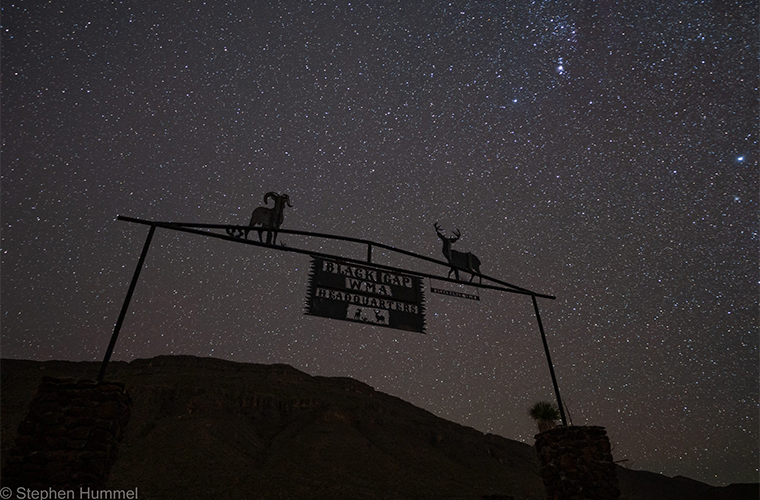
BREWSTER COUNTY, Texas, USA – The Texas Parks and Wildlife Department (TPWD) is proud to announce that Black Gap Wildlife Management Area (BGWMA) has been designated as an International Dark Sky Sanctuary by the International Dark-Sky Association (IDA). It is the second TPWD-administered property to receive the Sanctuary designation, joining Devils River State Natural Area – Del Norte Unit designated in 2019. Within the TPWD system, there are now two International Dark Sky Sanctuaries and four International Dark Sky Parks (Big Bend Ranch State Park Complex, Copper Breaks, South Llano River State Park, and Enchanted Rock State Natural Area ) designated by the IDA.
Black Gap shares a boundary with Big Bend National Park and is a short distance away from Big Bend Ranch State Park (BBRSP), both International Dark Sky Parks, making this area of the Big Bend one of the largest contiguous areas under dark-skies protection in the United States.
At approximately 103,000 acres, Black Gap WMA is the largest WMA managed by the Wildlife Division of TPWD. It is located in the rugged and remote Trans-Pecos region of far west Texas in the Chihuahuan Desert. The Trans-Pecos encompasses seven of the largest and most sparsely populated counties in the state. It is surrounded by protected public lands on both sides of the international border with Mexico.
Black Gap shares its western and southern boundaries with Big Bend National Park, the fourteenth largest park in the National Park Service system at over 800,000 acres. Its eastern boundary follows 25 miles of the Rio Grande and borders the Mexican State of Coahuila at the U.S./Mexico border. This stretch of the Rio Grande is part of the Rio Grande Wild and Scenic River which represents 196 miles of federally protected river course celebrated for its natural and cultural significance.
“This designation will help preserve the night skies in the Big Bend Region of Texas and will serve as an economic benefit to the area overall. It will aid in the future goal of establishing a Dark Sky Reserve in the local area,” said Travis Smith, Natural Resource Specialist III who manages Black Gap. Mark Garrett, Project Leader for the Trans-Pecos Wildlife Management Areas echoed Smith’s statement adding that, “we recognize the value of natural nighttime darkness and are fully committed to protecting it as any other element of conservation.”
This effort was led by Amber Harrison, an Interpretive Ranger at BBRSP with the goal of strengthening existing protections, as well as extending outreach and programming to focus on the entire region. “We are always looking for ways to strengthen our partnerships within the region…we want to expand responsibly so your dark skies can be experienced by those who live here alongside those who are visiting,” said Cassie Cox, Regional Interpretive Specialist for Region 1.
As part of this initiative, BBRSP revised their Interpretive Management Plan and extended their Dark Sky Steward volunteer program to include Black Gap. The Dark Sky Steward volunteer program helps monitor the condition of the night sky over time. It enlists volunteers with experience in astronomy and/or astrophotography to gather observations of the night sky from various locations. The observations and images generated by our volunteers are used to track the quality of the night sky, as well as for promotional and educational purposes.
Not only does this designation mean continued protection of pristine night skies, but it also represents a collaboration between the State Parks and Wildlife divisions of TPWD, our partners at the McDonald Observatory, and local advocacy groups – all working together for the greater goal of becoming an International Dark Sky Reserve. “The commitment from all members in this community will pave the way for a landscape-scale conservation approach that will provide the greatest impact for preserving night skies in this area,” stated Ruskin Hartley, Executive Director of IDA.
The IDA is a 501(c)(3) nonprofit organization based in Tucson, Arizona, which advocates for the protection of the nighttime environment and dark night skies. It does so by educating policymakers and the public about night sky conservation and through the promotion of environmentally responsible outdoor lighting. The IDA established the International Dark Sky Places conservation program in 2001 to recognize excellent stewardship of the night sky. Designations are based on stringent outdoor lighting standards and innovative community outreach. Currently, 32 Communities, 106 Parks, 18 Reserves, 14 Sanctuaries, two Urban Night Sky Places, and six Dark Sky Friendly Developments of Distinction are recognized with International Dark Sky Places designations.
Contact Amber Harrison at the Barton Warnock Visitor Center at 432-424-3327 for more information on the Dark Sky Steward program and visit the Dark Skies Program page (https://tpwd.texas.gov/spdest/programs/dark_skies/) on the TPWD website to learn more about the initiative.
More information about the IDA, its mission, and work may be found at http://www.darksky.org.
Also, visit http://darksky.org/idsp to find out more about the International Dark Sky Places conservation program.
Tagged with dark sky, lightED